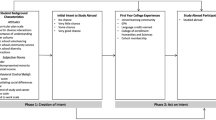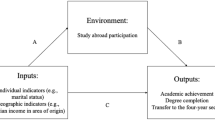Abstract
This study examined US undergraduate students’ intent to study abroad upon college entry and their actual participation in study abroad during their undergraduate years, correlating the college outcomes of three cohorts to identify trends. The findings show that study abroad intent and participation are interrelated and shaped by an array of factors, including gender, race or ethnicity, major, and involvement in college activities. While mathematical ability and helping to promote racial understanding negatively affected study abroad intent, aspiring to earn an advanced degree, time spent socializing with friends, artistic ability, seeking to improve understanding of other countries and cultures, and expectations to join a social fraternity or sorority, to be satisfied with college, and to participate in student clubs or groups positively influenced study abroad intent. Also, the findings indicate that involvement in the student government, a music or theater group, a political club, club sports, and off-campus study negatively affected participation in study abroad. Finally, the findings reveal that study abroad made a unique contribution to college outcomes, such as understanding moral and ethical issues, communication skills, academic performance, and overall satisfaction. Implications for higher education researchers, study abroad professionals, senior administrators, faculty advisors, and college students are discussed.
Similar content being viewed by others
References
Barron’s Profiles of American Colleges. (1996). Hauppage. NY: Barron’s Educational Series.
Bloom, B. S. (1994). Reflections on the development and use of the taxonomy. In L. W. Anderson & L. A. Sosniak (Eds.), Bloom’s taxonomy: A forty year retrospective (Ninety third yearbook of the National Society for the Study of Education, Part II) (p. 18). Chicago: National Society for the Study of Education.
Booker, R. W. (2001). Differences between applicants and non-applicants relevant to the decision to apply to study abroad. (Ph.D., University of Missouri—Columbia).
Carlson, J. S., Burn, B. B., Useem, J., & Yachimowicz, D. (1990). Study abroad: The experience of American undergraduates in Western Europe and the United States. New York: Greenwood Press.
Carter, H. (1991). Minority access to international education. In Black Students and Overseas Programs: Broadening the Base of Participation, CIEE, Ed., pp. 6–13, CIEE: Council on International Educational Exchange, New York, NY, USA, 1991.
Citron, J. L. (2002). U.S. students abroad: Host culture integration or third culture formation? In W. Grünzweig & N. Rinehart (Eds.), Rockin’ in Red Square: Critical approaches to international education in the time of cyberculture (pp. 41-56). Munster, Germany: Lit Verlag.
Clemens, C. R. (2003). A descriptive study of demographic characteristics and perceptions of cross cultural effectiveness of diverse students at Ohio University in relation to study abroad (Doctoral dissertation, Ohio University, 2002).
Coldwell, W. (March 6, 2013) Lack of information turns students off studying abroad. http://www.guardian.co.uk.
Creswell, J. W. (2011). Research design: Qualitative, quantitative, and mixed methods approaches (3rd ed.). Thousand Oaks: Sage.
Cubillos, J. H., Chieffo, L., & Fan, C. (2008). The impact of short-term study abroad programs on L2 listening comprehension skills. Foreign Language Annals, 41, 157–185.
Dessoff, A. (2006). Who’s not going abroad? International Educator, 15(2), 20–27.
DiBiasio, D., & Mello, N. (2004). Assessing a nontraditional study abroad program in the engineering discipline. Frontiers, 10, 237–252.
Dolby, N. (2004). Encountering an American self: Study abroad and national identity. Comparative Education Review, 48(2), 150–173.
Dolby, N. (2007). Reflections on nation: American undergraduates and education abroad. Journal of Studies in International Education, 11(2), 141–156.
Drew, C. (November 4, 2011). Why science majors change their minds (It’s just so darn hard). The New York Times.
Engle, J., & Engle, L. (2002). Neither international nor educative: Study abroad in the time of globalization. In W. Grünzweig & N. Rinehart (Eds.), Rockin’ in Red Square: Critical approaches to international education in the time of cyberculture (pp. 25–40). Munster: Lit Verlag.
Fischer, K. (2012, Februray 19). In study abroad, men are hard to find. Chronicle of Higher Education. https://chronicle.com/article/In-Study-Abroad-Men-Are-Hard/130853/.
Fornerino, M., Jolibert, A., Sáchez, C. M., & Zhang, M. (2011). Do values or goals better explain intent? A cross-national comparison. Journal of Business Research, 64, 490–496.
Gammonley, D., Rotabi, K. S., & Gamble, D. N. (2007). Enhancing global understanding with study abroad: Ethically grounded approaches to international learning. Journal of Teaching in Social Work, 27(3–4), 115–135.
Gary, K. S., Murdock, G. K., & Stebbins, C. D. (2002). Assessing study abroad’s effect on an international mission. Change, 34(3), 44–51.
Geelhoed, R., Abe, J., & Talbot, D. (2003). A qualitative investigation of US students’ experiences in an international peer program. Journal of College Student Development, 44, 5–17.
Golay, P. A. (2006). The effects of study abroad on the development of global-mindedness among students enrolled in international programs at Florida State University. (Ed.D., The Florida State University).
Goldstein, S. B., & Kim, R. I. (2006). Predictors of US college students’ participation in study abroad program: A longitudinal study. International Journal of Intercultural Relations, 30, 507–521.
Graban, J. L. (2007). The effects of study abroad experience on student cognitive and affective outcomes of college. (Ph.D., Indiana State University).
Green, M. F., Luu, D., & Burris, B. (2008). Mapping internationalization on US Campuses (2008th ed.). Washington DC: American Council on Education.
Hadis, B. F. (2005). Why are they better students when they come back? Determinants of academic focusing gains in the study abroad experience. Frontiers, 11, 57–70.
Heisel, M., & Stableski, R. (2009). Expanding study abroad: Where there’s a will, there’s a way. In P. B. R. Gutierrez (Ed.), Expanding study abroad capacity at US colleges and universities. New York: Institute of International Education.
Hoffa, W. (2007). A history of US study abroad: Beginnings to 1965. Carlisle: The Forum on Education Abroad.
Institute of International Education. (2013). Profile of US study abroad students, 2001/02–2011/12. Open Doors report on international exchange. Retrieved from http://www.iie.org/opendoors.
Kasravi, J. (2009). Factors influencing the decision to study abroad for students of color: Moving beyond the barriers (Ph.D., University of Minnesota-Twin Cities).
Kitsantas, A. (2004). Studying abroad: The role of college students’ goals on the development of crosscultural skills and global understanding. College Student Journal, 38, 441–452.
Langley, C. S., & Breese, J. R. (2005). Interacting sojourners: A study of students studying abroad. The Social Science Journal, 42, 313–321.
Laubscher, M. (1994). Encounters with difference: Student perceptions of the role of out-of-class experiences in education abroad. Westport: Greenwood.
Lincoln Commission. (2005). Global competence and national needs: One million Americans studying abroad. Final Report from the Commission on the Abraham Lincoln Fellowship Program, Washington DC.
Lozano, J. E. (2008). Exploring students’ decisions regarding studying abroad: A study of private university students in south Texas. Abstract retrieved December 20, 2009 from ProQuest Dissertations & Theses. Dissertation Abstracts International, 69(03). (UMI No. 3305622).
Luo, J., & Jamieson-Drake, D. (2005). Linking student precollege characteristics to college development outcomes: The search for a meaningful way to inform institutional practice and policy. IR Applications, 7, 1–17.
Luo, J., & Jamieson-Drake, D. (2013). Examining the educational benefits of interacting with international students. Journal of International Students, 3, 85–101.
Magnan, S. S., & Back, M. (2007). Social interaction and linguistic gain during study abroad. Foreign Language Annals, 40, 43–61.
Matthews, P. R., Hameister, B. G., & Hosley, N. S. (1998). Attitudes of college students toward study abroad: Implications for disability service providers. Journal of Postsecondary Education and Disability, 13(2), 67–77.
McKeown, J. S. (2006). The impact of study abroad on college student intellectual development. (Ph.D., Syracuse University).
NAFSA: Association of International Educators. (2003). Securing America’s future: Global education for a global age. Washington, DC: Report of the Strategic Task Force on Education Abroad.
Nesdale, D., & Todd, P. (1993). Internationalizing Australian universities: The intercultural contact issue. Journal of Tertiary Education Administration, 15, 189–202.
Paige, R. M., Cohen, A. D., Kappler, B., Chi, J. C., & Lassegard, J. P. (2002). Maximizing study abroad: A students’ guide to strategies for language and culture learning and use. Minneapolis: University of Minnesota.
Pascarella, E. T., & Terenzini, P. T. (1991). How college affects students. San Francisco: Jossey-Bass.
Pascarella, E. T., & Terenzini, P. T. (2005). How college affects students (Vol. 2): A third decade of research. San Francisco, CA: Jossey-Bass.
Peterson, D. L. (2003). The decision to study abroad: Contributing factors and implications for communication strategies (Doctoral dissertation). Retrieved from Dissertations and Theses database. (UMI No. 3092192).
Posey, J. T. Jr. (2003). Study abroad: Educational and employment outcomes of participants versus nonparticipants. (Ph.D., The Florida State University).
Pryor, J. H., Hurtado, S., Saenz, V. B., Santos, J. L., & Korn, W. S. (2007). The American freshman: Forty years trends. http://www.heri.ucla.edu/PDFs/pubs/TFS/Trends/Monographs/TheAmericanFreshman40YearTrends.pdf.
Ryan, M. E., & Twibell, R. S. (2000). Concerns, values, stress, coping, health and educational outcomes of college students who studied abroad. International Journal of Intercultural Relations, 24, 409–435.
Salisbury, M. H. (2011). The effect of study abroad on intercultural competence among undergraduate college students. Doctoral dissertation, University of Iowa, 2011. http://ir.uiowa.edu/etd/1073.
Salisbury, M. H., Paulsen, M. B., & Pascarella, E. T. (2010). To see the world or stay at home: Applying an integrated student choice model to explore the gender gap in the intent to study abroad. Research in Higher Education, 51, 615–640.
Salisbury, M. H., Paulsen, M. B., & Pascarella, E. T. (2011). Why do all the study abroad students look alike? Applying an integrated student choice model to explore differences in the factors that influence white and minority students’ intent to study abroad. Research in Higher Education, 52, 123–150.
Salisbury, M. H., Umbach, P. D., Paulsen, M. B., & Pascarella, E. T. (2009). Going global: Understanding the choice process of the intent to study abroad. Research in Higher Education, 50, 119–143.
Selingo, J. (March 26, 2013). Wanted at work: Take more risks in college. http://www.linkedin.com/today/post/article/20130326135541-17000124-wanted-at-work-take-more-risks-in-college.
Shirley, S. W. (2006). The gender gap in post-secondary study abroad: Understanding and marketing to male students (Doctoral dissertation, The University of North Dakota, 2006). http://www.departments.dsu.edu/deanofstudents/steveshirleydissertation.pdf.
Silver, A. (March 7, 2012). Science concentrators less likely to study abroad. The Brown Daily Herald.
Spiering, K., & Erickson, S. (2006). Study abroad as innovation: Applying the diffusion model to international education. International Education Journal, 7, 314–322.
Stallman, E., Woodruff, G. A., Kasravi, J., & Comp, D. (2010). The diversification of the student profile. In W. W. Hoffa & S. C. DePaul (Eds.), A history of US study abroad: 1965-present. Lancaster, PA: Frontiers: The Interdisciplinary Journal of Study Abroad.
Stroud, A. H. (2010). Who plans (not) to study abroad? An examination of US student intent. Journal of Studies in International Education, 20(10), 1–18.
Twombly, S. B., Salisbury, M. H., Tumanut, S. D., & Klute, P. (2012). Study abroad in a new global century: Renewing the promise, refining the purpose. ASHE Higher Education Report, 38 (4).
Van Der Meid, J. (2003). Asian Americans: Factors influencing the decision to study abroad. Frontiers, 9, 71–110.
Vande Berg, M. (2007). Intervening in the learning of US students abroad. Journal of Studies in International Education, 11(3/4), 392–399.
Washington, D. D. (1998). African-American undergraduate students’ perceptions of and attitudes toward study abroad programs. Dissertation. Virginia: George Mason University.
Williams, T. R. (2005). Exploring the impact of study abroad on students’ intercultural communication skills: Adaptability and sensitivity. Journal of Studies in International Education, 9, 356–371.
Wynveen, C. J., Kyle, G. T., & Tarrant, M. A. (2012). Study abroad experiences and global citizenship: Fostering proenvironmental behavior. Journal of Studies in International Education, 6(4), 334–352.
Acknowledgments
We would like to thank the editor and two anonymous reviewers for their comments on the manuscript.
Author information
Authors and Affiliations
Corresponding author
Rights and permissions
About this article
Cite this article
Luo, J., Jamieson-Drake, D. Predictors of Study Abroad Intent, Participation, and College Outcomes. Res High Educ 56, 29–56 (2015). https://doi.org/10.1007/s11162-014-9338-7
Received:
Published:
Issue Date:
DOI: https://doi.org/10.1007/s11162-014-9338-7




